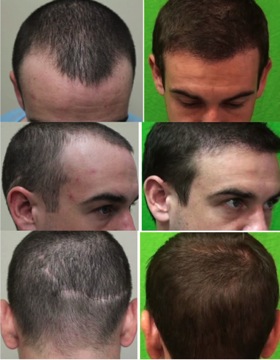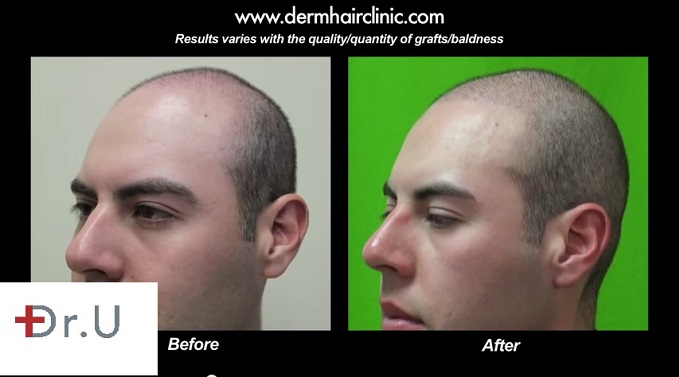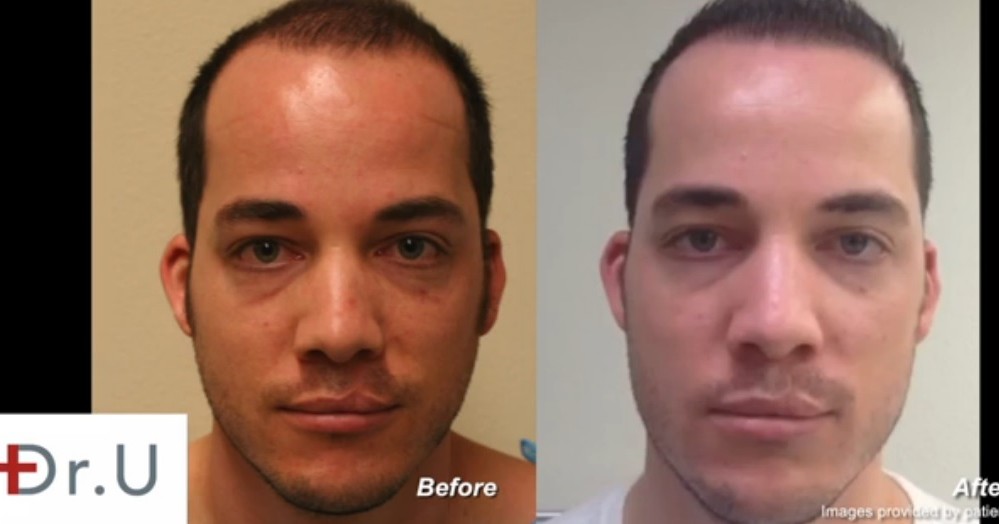
Typically, hair clinics will consider hair restoration for younger patients aged 24 and under. This is due to the fact that male pattern baldness is progressive in nature and a premature hair loss would undermine the long-term results. The implanted hair would stay put as the continuation of baldness would persist in surrounding areas, yielding an unnatural-looking island of hair.
There can be however caveats and exception to this general rule of thumb. These exceptions can be applied in the following instances when considering hair transplantation for younger patients:
- The candidate understands that a second, or even third procedure will be necessary in the future and accepts this likelihood (therefore, planning for financial stability to pursue multiple FUE hair restorations is essential)
- The candidate has already severe hair loss at a young age and it is evident that he is going to be extremely bald and the hair transplant planning takes that into account
- The candidate is reconciled to the need for more surgeries in the future and has a good head and nonhead donor reserve to cover for even the most extreme future hair loss. This supposes that a competent clinic capable of harnessing nonhead hair has assessed the patient. It is also advisable to be conservative in patients that are in their earlier stages of hair loss
Hair Restoration for Younger Patients: Discerning Premature Treatment
Most clinics look to a few telling factors in order to determine if a candidate is too young for surgery. The first of these is the patients Norwood level of baldness, the second is how quickly the balding has progressed thus far, and the third is the family history.
At DermHair Clinc, Dr Umar specializes in the use of nonhead hair and head hair for the restoration of even extreme bald states. The totality of the 3 factors mentioned above is used by him in determining the candidacy of a young patient for a hair transplant.
A clinic that is unable to use nonhead donor hair is likely to turn away most patients on the basis of a young age of presentation.
Additionally, Dr U has pioneered processes for determining permanent donor areas of the scalp. He described for the first time a maneuver called “The FUE SHAVE TEST” for determining patients that would be severely bald and likely to loose their nape hair and hairs outside of the traditional safe donor areas SDA in this groundbreaking publication in the Aesthetic Surgery Journal
Example of Hair Restoration for Younger Patients
This patient presented to DermHair Clinic at the young age of 23, with extreme balding, and a very limited supply of scalp donor hair. He also had no body hair. After the necessary questioning and testing, Dr. Umar decided this patient was an exception to the rule. He used FUE hair restoration with a very small graft count to give global coverage to the patient’s buzz cut.

FUE is an ideal procedure for young patients because it produces nominal scarring and minimal damage to the donor area, leaving enough donor hair to supply a future surgery.
Are Men Today Losing Their Hair Earlier Than Before
Many people are speculating that hair loss is striking males at earlier ages than before. In August of 2014, Yahoo Health published an article, “Why Men Are Going Bald Younger.” On a site called Experience Project, one user posed the question, “Why does it seem like young men (20s-30s) are going bald earlier in life?”
Albert Mannes PhD, from the University of Pennsylvania expressed that baldness has traditionally been associated with old age. But now that we are noticing a greater number of younger men being affected by noticeable hair loss, this perception may be on it’s way to becoming outdated.
As of yet, research has not confirmed that baldness is hitting today’s generation harder than previous ones. And thus, scientists have not come up with solid explanations.
Genetic and Environmental Forces in Hair Loss
In his interview with American Health Journal, Dr. U explained that environmental factors can certainly influence the rate of genetic hair loss. Therefore, it is quite reasonable that pollution and the collective stress of modern living are exacerbating hair loss in those who are predisposed to androgenic alopecia.
Genes contain instructions for making proteins in our bodies. In those with pattern baldness, DNA sequences will create more sensitive androgen protein receptors on the hair follicle. A byproduct known as DHT (formed from the breakdown of testosterone) will bind to these receptors and inhibit the absorption of nutrients from the blood). This causes the follicles to shrink. Hair will grow thinner and permanently fall out.
Losing Hair Earlier in Life May Be A Good Thing
According to Cancer Epidemiology, research studies suggest that those affected by androgenic alopecia earlier in life may have a much lowered risk (29-45% less than average) of developing prostate cancer. This contradicts earlier findings which suggested the opposite relationship, that early hair loss is correlated with a higher risk.
It is believed that testosterone is responsible for facilitating the formation of prostate tumors. But exposure to higher levels of testosterone (and thus DHT) earlier in life may actually prevent this development.
When Hair Loss Is Not Related to Common Pattern Baldness
Aside from a genetic genetic predisposition for common pattern baldness, there are five common causes for hair loss that may affect younger people.
(1) The first common cause is tinea capitis—a condition cause by a fungus that invades the hair shaft and causes the hair to break. This is most commonly found in children especially those of school going age.
(2) The next is alopecia areata which is the sudden appearance of one or more totally bald areas in the scalp (patchy hair loss).
(3) Traction alopecia, or physical damage to the hair, is another cause of hair loss. More common in girls, the hair does not respond well to many physical and chemical reactions it has to endure. It is commonly a result of hair grooming practices especially in women of color. Practices like hair braiding, the use of extensions and the use of hot combs as well as tight pony tails.
(4) The fourth common cause of hair loss is trichotillomania—the compulsion to pull out one’s own hair.
(5) The last common form of hair loss is called telogen effluvium, which is when a illness or stress-related event causes the hair to shed.
Treatment for Early Hair Loss
Prolific losses of hair should be examined and addressed as soon as possible with the help of a doctor. There are many potential contributors that may be at work. A qualified doctor would be able to find out if medical conditions, prescription side effects, nutritional deficiencies or other variables should be addressed.
Although there are two FDA approved drugs available for managing pattern baldness, these medications are associated with severe side effects, like all pharmaceutical products. Therefore, patients are advised to carefully weigh the potential for risks against any proposed benefits. As more individuals are seeking new answers to many forms of health issues in the world of natural plant based treatments, researchers around the world are following suit and conducting controlled studies with some rather surprising findings on the effectiveness of various extracts. It may be worth while to become familiar with such research and consider the role of natural treatments in one’s fight against hair loss. In so doing, the help of a specialist is recommended.

